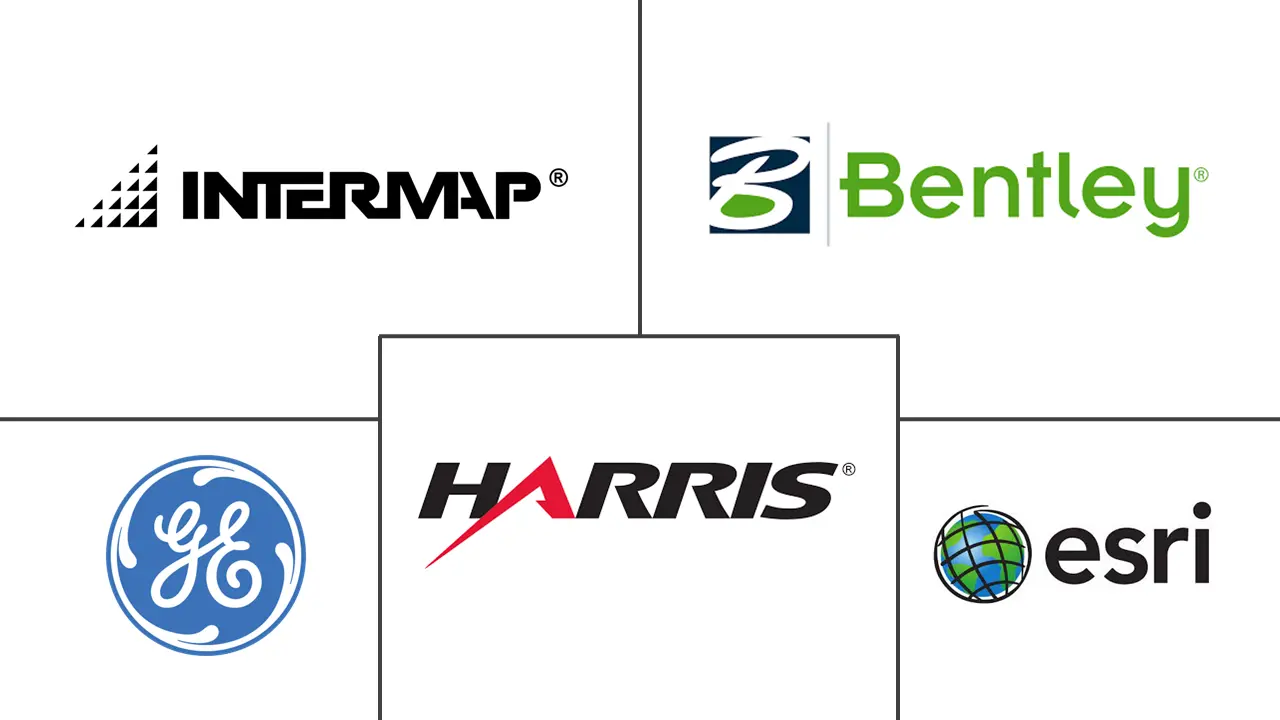Canada Geospatial Analytics Market Size and Share
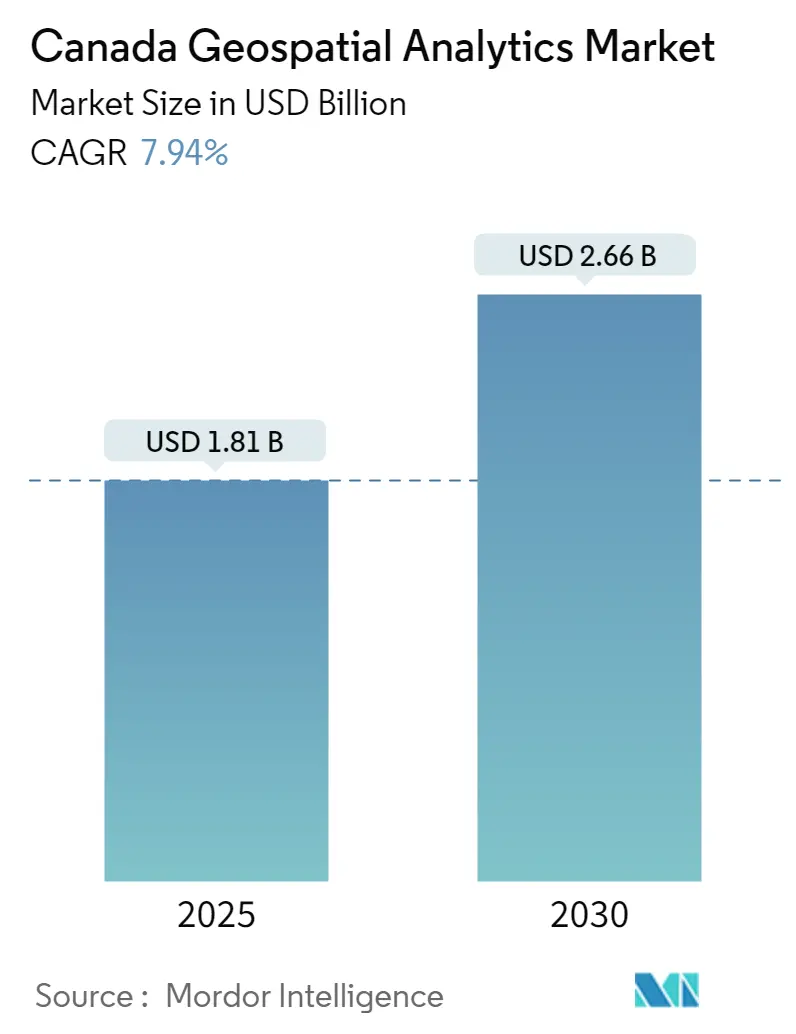
Canada Geospatial Analytics Market Analysis by Mordor Intelligence
The Canada Geospatial Analytics Market size is estimated at USD 1.81 billion in 2025, and is expected to reach USD 2.66 billion by 2030, at a CAGR of 7.94% during the forecast period (2025-2030).
Geospatial analysis refers to a broad range of activities that emphasize applying various techniques to data comprising geographical or space-related characteristics. The increasing use of GPS devices, technological advancements in the field of GIS technology, recent trends in the integration and convergence of geospatial technologies, the emergence of new business models aimed at leveraging the demand for geospatial information, and the increased application of geospatial analytics in city and town planning are some of the primary factors driving the expansion of the market for geospatial analytics.
- Geospatial analytics may be helpful in construction. Builders and developers may make educated decisions based on data-driven insights about location, zoning, and available resources using Geographic Information Systems (GIS) tools. GIS technology may help with anything from site selection to project management in home development. GIS, for example, may be used to analyze the terrain of a possible construction site to assess its suitability for development. Furthermore, GIS may assist builders in identifying potential environmental dangers that must be considered during development.
- According to Canada Mortgage and Housing Corporation, The number of dwelling units under construction in Canada in December of 2022 was approximately 334,100. Further, according to StatCan, in 2022, there were 261.85 thousand housing units under construction. Such a vast number of residential buildings would drive the studied market. There is an increasing rate of urbanization, hence, to create self-sustaining cities where a diverse set of drivers, such as quality of life, economic development, energy faculty, mobility, governance, security, living conditions, free movement, and people, are in constant flux, geospatial technology is central to providing a technological platform that forms the backbone of a city.
- Further, the significant features that have made Geovisualization invaluable for today's businesses are thematic mapping, heat maps, drawing and querying, and data points that can be represented numerically and graphically.
- Drawing and querying help a business isolate a particular geographic area and learn more about its demographic profile against its current CRM. Ride-hailing start-ups like Uber are extensively using geovisualization. Uber's Kepler. Gl geospatial tool, now an open source, is a geospatial data visualization tool that doesn't require coding, works in the browser, doesn't need to be installed, can render millions of GPS points, and is simple to use.
- Conversely, implementing new technology brings with it new challenges that may involve privacy-related concerns, as in the case of GIS and other mapping technologies. There have been several instances where gathering geospatial data earned the wrath of regional privacy and demographics laws. Ideally, new technologies need to be embraced and integrated into the social discourse to enable end users to gain benefits.
- However, certain governmental agencies have been very cautious about the 'democratization' of data, specifically in the case of sensitive installations. Societal responses to privacy issues that have come up because of the integration of GIS and GPS have primarily been mixed. However, there has also been an overriding sense of optimism over the benefits geospatial data offers.
Canada Geospatial Analytics Market Trends and Insights
Network Analysis is Expected to Hold Significant Share of the Market
- Network Analysis enables end-users to incorporate location-based information into their decision-making process. In several cases, firms must consider all possible cases for making effective decisions regarding cost and resources. GIS is widely used for studying real-world problems related to operations research and flow-related issues, such as transportation research. Some significant applications of network analysis in operations research include selecting the best route, shortest path analysis, optimal allocation of finite resources, network partitioning, selection of closest maintenance facility, and location-allocation, among others.
- The use of network analysis has gained prominence in today's cities, which are becoming increasingly congested. For instance, in the case of any emergency response system (ERS), the best route or shortest path analysis data using spatial data directly improves the fire emergency response, police station emergency response, healthcare emergency response system, etc. Google Maps extensively uses spatial data to provide multiple routes, the best routes, and real-time analysis to re-route in case the user cannot follow the suggested path.
- The players in the market are collaborating to provide better services to its customer and expand their market presence. For example, Mapbox, one of the prominent mapping and location cloud platforms for developers, and Ookla, the renowned company that developed Speedtest and Downdetector, have joined forces worldwide to develop ground-breaking network-aware mapping solutions. Technologies that offer significant new value to each company's customers will be developed together. Because of their combined capabilities and expertise, Ookla and Mapbox are uniquely positioned to transform connectivity-aware mapping features and geospatial network analysis.
- Geospatial network analysis is crucial in the mining industry to identify essential habitat patches and plan and manage mining operations. With the help of geographic information systems (GIS), spatial databases, and specialized software tools, mining companies can perform spatial analyses, create linear networks of interconnected features, and perform detailed spatial analyses on them.
- Such tools help identify ecological sources based on morphology, create vector-based network analysis to optimize transportation, and use spatial data mining to solve complex problems. According to US Geological Survey, Canada's gold production from mines was estimated to be 200 metric tons in 2023. Such huge mining capacity would drive the studied market.
- GIS network analysis has also been applied in Canada to solve transportation problems. For example, fleet management uses GIS network analysis to solve scheduling problems and stay on route. Network analysis tools in GIS have been used to perform multiple closest facility analyses, such as identifying the closest hospital or emergency services during an incident. Another application of geospatial network analysis in Canada is identifying influential nodes in the air pollution spatial correlation weighted network. Researchers have used spatial correlation analysis to analyze air pollution and identified influential cities to prioritize environmental interventions. .
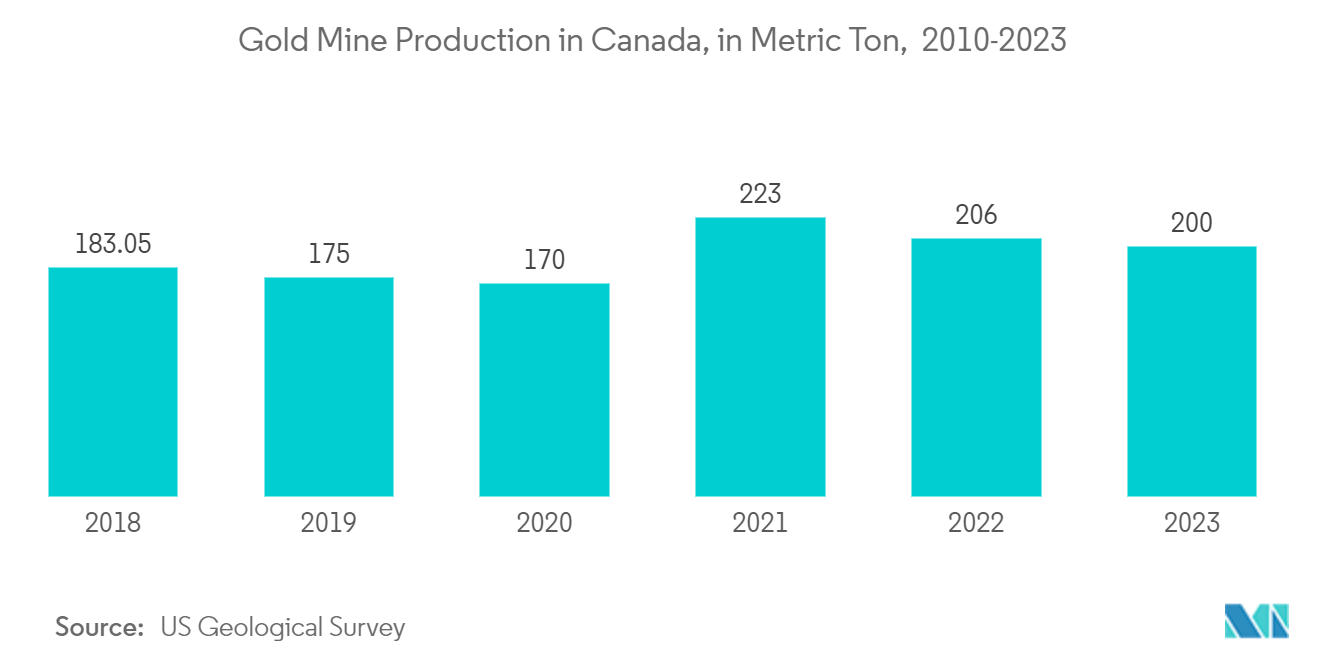
Utility and Communication is Expected to Hold Significant Share of the Market
- Utility and Communication is a prominent end-user industry that has adopted geospatial analytics. The segment contains mostly energy and power, and communication systems. Analytic techniques used in the sector determine energy consumption profiles of high-resolution buildings, using a method that combines annual energy simulations of various city-specific prototypical assets and geospatial data, from the Geographical Information System (GIS) framework.
- According to statcan, when compared to the same month a year earlier, hydroelectricity generation in Canada decreased by 4.1% to 34.9 million MWh in February 2022, despite continuing to be the single largest contributor to electricity generation in the country (62.1% of total generation). Additionally, the amount of electricity produced from combustible fuels, such as biomass, decreased by -8.4% to 10.4 million MWh. In February, increases in generation from wind power (+19.9 percent) and nuclear energy (+14.8%) were reported.
- China is the leading country in the world for installing wind power capacity, exceeding the United States which is ranked second. By the end of 2023, China had installed more than 464 gigawatts of wind power, whereas the United States had only installed 150 gigawatts of wind energy. By using geospatial technologies, it is possible to identify areas with high wind speeds and assess their potential for generating wind power.
- Communications companies in the region are taking the help of geospatial analytics to determine the location of new cell phone tower installations. Geospatial data obtained from the devices is used to measure signal strength from particular towers in that location, and the range of that signal is used to understand the lack of coverage and signal strength. Various parameters, like population density, road positioning, and customer location, are considered to decide the location of the new cell tower installation.
- Analysis of geospatial data can also allow communications companies to manage their assets effectively. For instance, a company can analyze geospatial data to understand the power outage vulnerability of a site in the event of a storm, thereby managing its network assets. Furthermore, the company can also understand the deployment of its service assets (such as repair crews) to determine how to position them in case maintenance is needed.
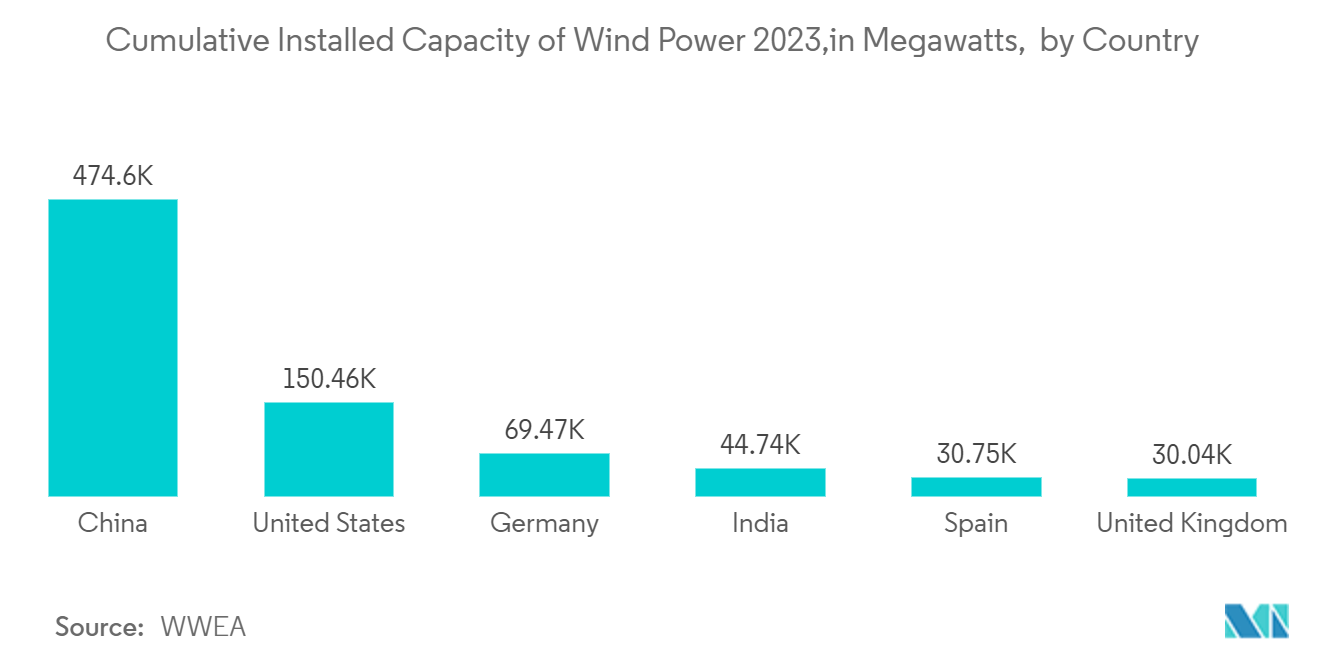
Competitive Landscape
The Canada geospatial analytics market is moderately consolidated with the presence of several players like Harris Corporation,Bentley Systems, Inc., General Electric, ESRI inc. etc. The companies continuously invest in strategic partnerships and product developments to gain substantial market share. Some of the recent developments in the market are:
- In December 2022, Carl Data Solutions, a player in predictive analytics for environmental monitoring as a service (EMaaS) and smart city applications driven by compliance, has signed a strategic partnership agreement with K2 Geospatial, a Montreal-based company. Over 350 cities and municipalities, seaports, airports, road authorities, and utilities across North America and Europe are among the 500 organizations using K2 Geospatial. JMap, a spatial analysis mapping integration platform made to connect silos in a fully integrated IT ecosystem, is used by K2 users.
- In September 2022, CAPE Analytics, a provider of AI-powered geospatial property intelligence, has partnered with weather technology firm Canopy Weather to launch a product for storm-related damage. Canopy Weather applies an application-first approach to deliver weather data products with specific, real-world business applications. Powered by machine learning, the rating indicates the likelihood of post-storm damage to roofs after severe weather. It can predict the subset of claims eligible for automated, straight-through processing with over 96% accuracy.
Canada Geospatial Analytics Industry Leaders
-
Harris Canada Inc
-
Bentley Systems, Inc.
-
General Electric
-
Intermap Technologies Inc
-
ESRI, Inc.
- *Disclaimer: Major Players sorted in no particular order
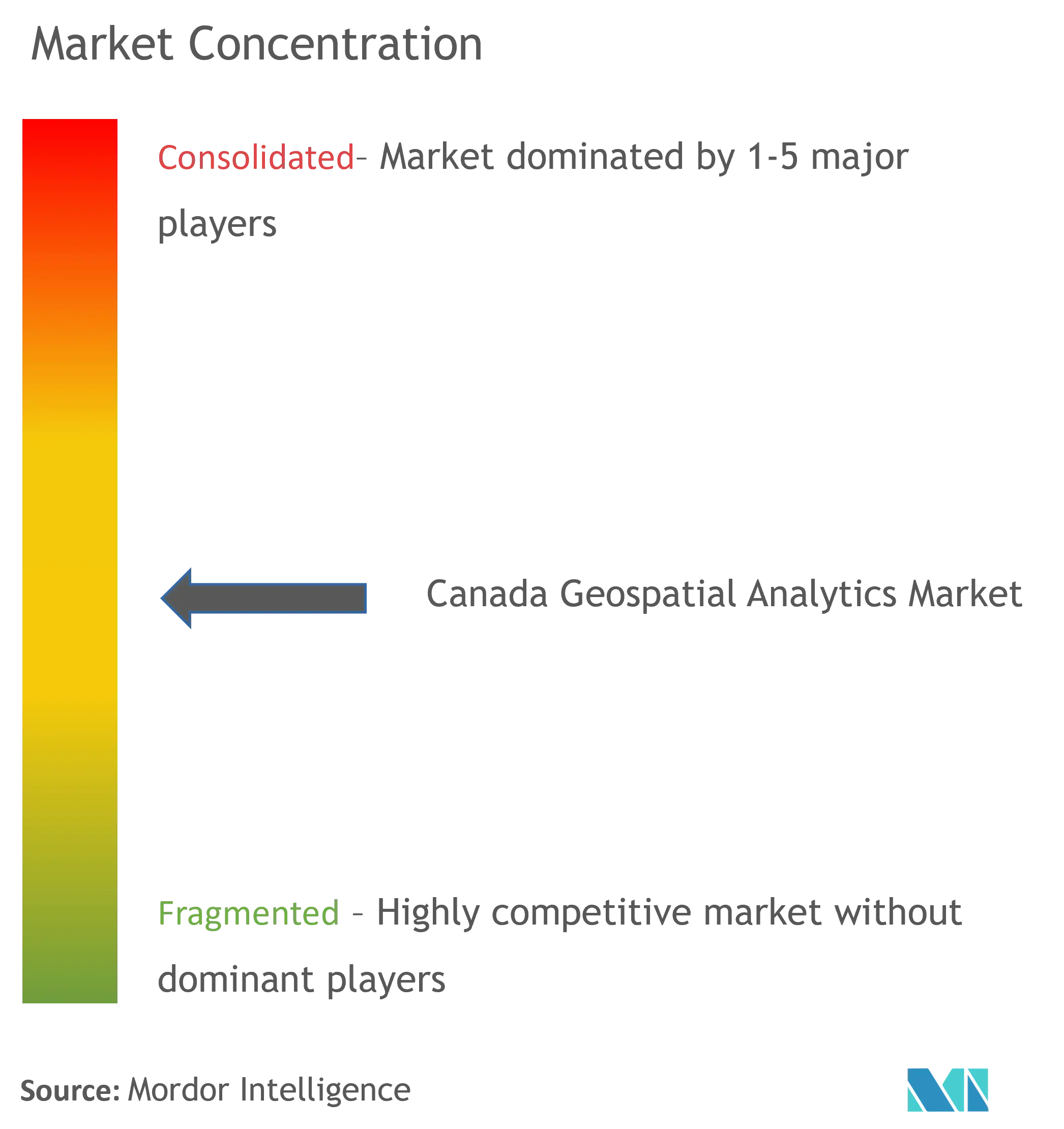
Recent Industry Developments
- Febrauray 2023 : Together with its partner Esri Canada, the City of Guelph was chosen as the Canadian city to lead the creation of a new emergency services geographic information system (GIS) database. As Canada implements a modernized Next Generation 9-1-1 (NG9-1-1) emergency response system, this innovative partnership, which received USD 1.017 million in federal grant funding, will support crucial enhancements in public safety in Guelph and throughout the country.
- June 2022 : Industries require X and Y coordinates for place names in order to locate, map, and evaluate various other forms of valuable geospatial data. Users in a variety of industries want to transform incomplete addresses or place names into intelligence that can be used in real-world situations. Esri, the global leader in location intelligence, has teamed up with real estate data analytics provider LightBox to provide advanced geocoding solutions in Canada to meet this demand. Both ArcGIS Online and ArcGIS Platform users can use the service. The LightBox enhancement will enable more precise geocoding of addresses, subaddresses, and locations with multiple units for rooftop locations.
Canada Geospatial Analytics Market Report Scope
Geospatial analytics is the process of acquiring, manipulating, and displaying imagery and data from the geographic information system (GIS), such as satellite photos and GPS data. The specific identifiers of a street address and a zip code are used in geospatial data analytics. They are used to create geographic models and data visualizations for more accurate trends modeling and forecasting.
The Canada geospatial analytics market is segmented by type (surface analysis, network analysis, geovisualization) , by end user vertical (agriculture, utility and communication, defence and intelligence, government, mining and natural resources, automotive and transportation, healthcare, real estate and construction). The market sizes and forecasts are provided in terms of value (USD) for all the above segments.
| Surface Analysis |
| Network Analysis |
| Geovisualization |
| Agriculture |
| Utility and Communication |
| Defense and Intelligence |
| Government |
| Mining and Natural Resources |
| Automotive and Transportation |
| Healthcare |
| Real Estate and Construction |
| Other End-user Verticals |
| By Type | Surface Analysis |
| Network Analysis | |
| Geovisualization | |
| By End-user Vertical | Agriculture |
| Utility and Communication | |
| Defense and Intelligence | |
| Government | |
| Mining and Natural Resources | |
| Automotive and Transportation | |
| Healthcare | |
| Real Estate and Construction | |
| Other End-user Verticals |
Key Questions Answered in the Report
How big is the Canada Geospatial Analytics Market ?
The Canada Geospatial Analytics Market size is expected to reach USD 1.81 billion in 2025 and grow at a CAGR of 7.94% to reach USD 2.66 billion by 2030.
What is the current Canada Geospatial Analytics Market size?
In 2025, the Canada Geospatial Analytics Market size is expected to reach USD 1.81 billion.
Who are the key players in Canada Geospatial Analytics Market ?
Harris Canada Inc, Bentley Systems, Inc., General Electric, Intermap Technologies Inc and ESRI, Inc. are the major companies operating in the Canada Geospatial Analytics Market .
What years does this Canada Geospatial Analytics Market cover, and what was the market size in 2024?
In 2024, the Canada Geospatial Analytics Market size was estimated at USD 1.67 billion. The report covers the Canada Geospatial Analytics Market historical market size for years: 2019, 2020, 2021, 2022, 2023 and 2024. The report also forecasts the Canada Geospatial Analytics Market size for years: 2025, 2026, 2027, 2028, 2029 and 2030.
Page last updated on:
Canada Geospatial Analytics Market Report
Statistics for the 2025 Canada Geospatial Analytics market share, size and revenue growth rate, created by Mordor Intelligence™ Industry Reports. Canada Geospatial Analytics analysis includes a market forecast outlook for 2025 to 2030 and historical overview. Get a sample of this industry analysis as a free report PDF download.
